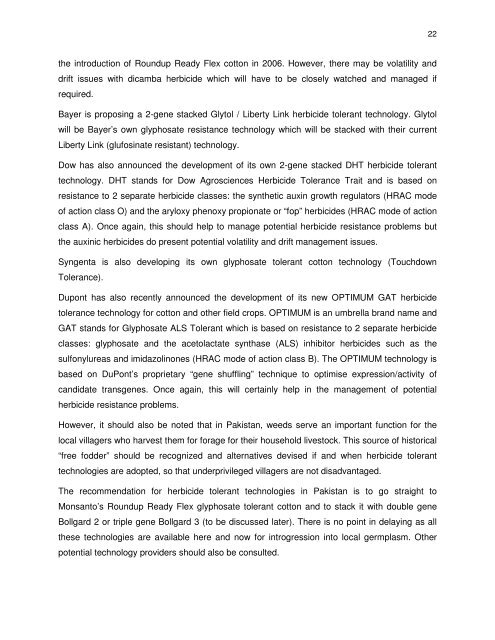ChangingCottonLandscapeNeilForrester
ChangingCottonLandscapeNeilForrester
ChangingCottonLandscapeNeilForrester
Create successful ePaper yourself
Turn your PDF publications into a flip-book with our unique Google optimized e-Paper software.
the introduction of Roundup Ready Flex cotton in 2006. However, there may be volatility and<br />
drift issues with dicamba herbicide which will have to be closely watched and managed if<br />
required.<br />
Bayer is proposing a 2-gene stacked Glytol / Liberty Link herbicide tolerant technology. Glytol<br />
will be Bayer’s own glyphosate resistance technology which will be stacked with their current<br />
Liberty Link (glufosinate resistant) technology.<br />
Dow has also announced the development of its own 2-gene stacked DHT herbicide tolerant<br />
technology. DHT stands for Dow Agrosciences Herbicide Tolerance Trait and is based on<br />
resistance to 2 separate herbicide classes: the synthetic auxin growth regulators (HRAC mode<br />
of action class O) and the aryloxy phenoxy propionate or “fop” herbicides (HRAC mode of action<br />
class A). Once again, this should help to manage potential herbicide resistance problems but<br />
the auxinic herbicides do present potential volatility and drift management issues.<br />
Syngenta is also developing its own glyphosate tolerant cotton technology (Touchdown<br />
Tolerance).<br />
Dupont has also recently announced the development of its new OPTIMUM GAT herbicide<br />
tolerance technology for cotton and other field crops. OPTIMUM is an umbrella brand name and<br />
GAT stands for Glyphosate ALS Tolerant which is based on resistance to 2 separate herbicide<br />
classes: glyphosate and the acetolactate synthase (ALS) inhibitor herbicides such as the<br />
sulfonylureas and imidazolinones (HRAC mode of action class B). The OPTIMUM technology is<br />
based on DuPont’s proprietary “gene shuffling” technique to optimise expression/activity of<br />
candidate transgenes. Once again, this will certainly help in the management of potential<br />
herbicide resistance problems.<br />
However, it should also be noted that in Pakistan, weeds serve an important function for the<br />
local villagers who harvest them for forage for their household livestock. This source of historical<br />
“free fodder” should be recognized and alternatives devised if and when herbicide tolerant<br />
technologies are adopted, so that underprivileged villagers are not disadvantaged.<br />
The recommendation for herbicide tolerant technologies in Pakistan is to go straight to<br />
Monsanto’s Roundup Ready Flex glyphosate tolerant cotton and to stack it with double gene<br />
Bollgard 2 or triple gene Bollgard 3 (to be discussed later). There is no point in delaying as all<br />
these technologies are available here and now for introgression into local germplasm. Other<br />
potential technology providers should also be consulted.<br />
22


